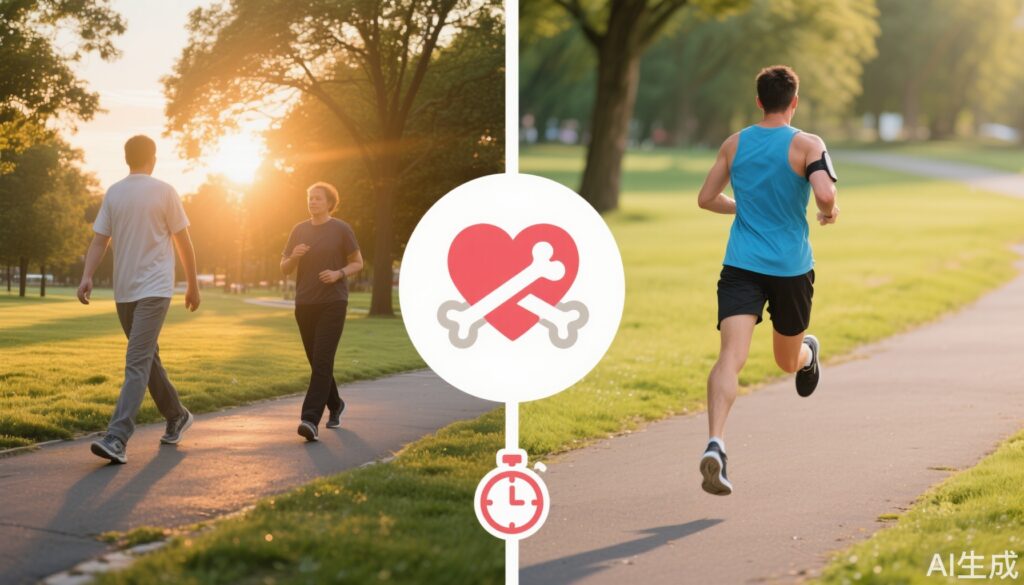Title
Three Miles: Should You Walk or Run? What the Science Says About Health Benefits, Risks, and Practical Choices
Background / Introduction
Everyone who’s tried to be more active has faced the simple question: if I cover three miles (about 5 km) today, does it matter whether I walked or ran? Both walking and running are accessible, low-cost ways to get moving. For many runners, a daily 5 km is a “sweet spot” that fits around life and delivers measurable fitness gains. For many walkers, a 5 km stroll after dinner is the easiest way to hit 8,000–10,000 daily steps.
Which is better for your health—walking or running the same distance? The short answer from recent cohort research is: both. But the nuance matters: when you compare people who run with those who walk, health outcomes are similar overall; when you compare equal energy expenditure, walking sometimes shows slightly larger associations with lower risks of certain conditions, while running may be better for improving metabolic efficiency and cardiorespiratory fitness once BMI is accounted for. The most important take-home: consistency beats mode.
What the Data Tell Us
A large prospective comparison that followed more than 33,000 runners and roughly 15,000 walkers for six years found that, overall, running and walking reduced risks of cardiometabolic conditions in broadly similar ways. When the researchers compared effects per 1 metabolic equivalent (MET) of energy expenditure, they reported the following associations:
– Running: each additional 1 MET expended was associated with a 4.2% lower risk of developing hypertension, a 4.3% lower risk of high cholesterol, a 12.1% lower risk of type 2 diabetes, and a 4.5% lower risk of coronary heart disease.
– Walking: each additional 1 MET expended was associated with a 7.2% lower risk of hypertension, a 7.0% lower risk of high cholesterol, a 12.3% lower risk of type 2 diabetes, and a 9.3% lower risk of coronary heart disease.
(For context: 1 MET is the energy cost of resting quietly. Activities are assigned MET values relative to that baseline; walking and running differ in MET intensity, but you can reach the same total MET-hours by walking longer or running shorter distances.)
At first glance, those percentages suggest walking has slightly larger protective associations than running for blood pressure and cholesterol. However, when investigators adjusted for body mass index (BMI), running showed stronger improvements in metabolic efficiency—indicating that runners’ gains in fitness and body composition explain some of the advantage.
Why might walking look better per MET for some outcomes? There are several plausible explanations:
– Walking is lower impact, so people can sustain it longer or more frequently without injury.
– Walking is easier to adopt and maintain for people with higher baseline risk, so study populations of walkers may include people who earn health gains despite higher baseline risk profiles.
– Measurement artifacts: energy expenditure estimates and self-reported activity can create differences in how METs are calculated for walking versus running.
The bottom line: both walking and running confer substantial and overlapping health benefits. If you choose either, do it consistently.
Misconceptions and Harmful Behaviors
– “Running must always be better than walking.” Not necessarily. Running generally requires more cardiovascular and musculoskeletal capacity; its benefits per unit time may be greater, but walking is easier to maintain, less injury-prone, and for equal energy output may confer similar or even greater reductions in some disease risks.
– “If I’m short on time, I should just sprint 3 miles occasionally.” Sporadic high-intensity spikes without a progressive buildup increase injury and cardiovascular risk, particularly in previously sedentary people.
– “If I’m overweight or older, I shouldn’t exercise because I’ll get hurt.” On the contrary: appropriate low-impact activity (brisk walking, aquatic exercise, cycling) is one of the safest and most effective strategies to reduce cardiometabolic risk and improve function. The risk of being inactive is usually greater than the risk of a supervised, progressive exercise program.
– “More is always better.” Excessive volume—running or walking for multiple hours every day without recovery—can blunt benefits, increase injury risk, and harm immune function. Some evidence shows that very prolonged sessions (>90 minutes) can produce diminishing or even adverse short-term effects on markers of inflammation and cardiac strain.
Correct Health Practices: Practical Guidance
How to choose the right mode and plan that maximizes benefit and minimizes harm.
1) Decide by priorities and constraints
– If your main objective is sustainability and low injury risk (older age, arthritis, recent injury, obesity): prioritize brisk walking.
– If your objective is time efficiency, faster improvement in VO2 max and fitness, and you are cleared medically and have some exercise base: prioritize running or include running intervals.
– If you want weight loss: both modes can be effective. Running burns more calories per minute; walking can be just as effective if total weekly energy expenditure is matched.
2) Frequency, duration, and weekly volume
– Aim for the widely recommended target: at least 150–300 minutes per week of moderate-intensity activity (brisk walking) or 75–150 minutes per week of vigorous activity (running), or an equivalent mix. Practically, 3–5 sessions per week of 30–60 minutes is a realistic plan for many people. The research summarized above found that sessions lasting 30–60 minutes are generally optimal; sessions exceeding ~90 minutes can produce transient negative effects.
3) Progress safely
– For previously sedentary people: start low (e.g., 10–15 minutes brisk walk daily) and increase total weekly volume by no more than 10% per week.
– If transitioning to running, use run–walk intervals (e.g., 1–2 minutes running, 3–4 minutes walking) and gradually lengthen running segments over weeks.
4) Warm-up, cool-down, and strength
– Warm up briskly for 5–10 minutes before faster running or walking.
– Include two strength-training sessions per week targeting legs, core, and gluteal muscles to reduce injury risk and support gait efficiency.
5) Hydration, fueling, and recovery
– Sip small amounts of water regularly during sessions >30–45 minutes in moderate climates; increase attention in heat.
– For high-intensity or long sessions, consider a sports drink with electrolytes and carbohydrates.
– Prioritize sleep and at least one rest or active-recovery day per week.
6) Monitoring and when to stop
– New chest pain, severe shortness of breath, lightheadedness, palpitations, or syncope require immediate medical attention.
– Persistent local pain with swelling, inability to bear weight, or altered gait warrants evaluation by a clinician or physiotherapist.
Expert Recommendations and Insights
– Consistency is the cardinal rule: choose the activity you are most likely to sustain.
– Work with a clinician or certified trainer if you have known cardiovascular disease, recent cardiac symptoms, or uncontrolled chronic disease.
– For most adults, a mix of aerobic (walking or running), strengthening, and balance training (especially for older adults) offers the best protection against disability and chronic disease.
Public-health guidance (consistent with major agencies) recommends achieving weekly targets by any combination of moderate and vigorous activities. Walking often wins as the most scalable public-health intervention—because it’s safe, inexpensive, and can be done by almost anyone.
Patient Scenario: What to Tell Patients
Meet Michael, 52. He is overweight (BMI 31), works a desk job, and has well-controlled hypertension on one medication. He wants to be more active and wonders whether he should run three miles or walk three miles.
Practical advice for Michael:
– Start with brisk walking. Michael’s joints, habit, and baseline fitness make walking the safest route to immediate gains.
– Aim for 30–60 minutes on most days of the week; if three miles at a brisk pace takes ~60 minutes, that’s an excellent target.
– After 6–8 weeks of regular walking, consider adding short running intervals if he feels ready—e.g., 30 seconds to 1 minute of easy running with 3–4 minutes walking, gradually increasing running time.
– Monitor blood pressure and any symptoms; since Michael has hypertension, clear him with his clinician before high-intensity running.
– Add twice-weekly strength sessions to improve weight-bearing tolerance and reduce the chance of running-related injuries.
This plan balances safety, gradual progression, and measurable health benefit. Over months, Michael will likely lower his blood pressure, improve lipid profile, and reduce diabetes risk—whether he continues walking or transitions to running—so long as he keeps moving.
Conclusion
When the question is “walk three miles or run three miles?” there is no universal winner. Recent cohort evidence comparing tens of thousands of walkers and runners suggests broadly similar cardiometabolic benefits when activity is sustained. Per unit of energy (per MET), walking has shown slightly stronger associations with lower blood pressure and cholesterol in some analyses, while running appears to produce larger improvements in metabolic efficiency after accounting for BMI.
For most people the right answer depends on safety, enjoyment, time, and injury risk. Walking is the best first step for older adults, beginners, people with high body mass, and for those who want the most sustainable change. Running is efficient for time-poor people who are medically cleared and have an adequate fitness base. The single most important prescription is a routine you can stick to—regular movement, gradually increased and supported by strength work and recovery, will deliver the biggest health dividends.
References
– Williams PT. Walking versus running for prevention of hypertension, high cholesterol, and diabetes: a prospective study of 33,000 runners and 15,000 walkers. (Large cohort results summarized in-text.)
– World Health Organization. WHO guidelines on physical activity and sedentary behaviour. 2020. https://www.who.int/publications/i/item/9789240015128
– U.S. Department of Health & Human Services. Physical Activity Guidelines for Americans, 2nd edition. 2018. https://health.gov/sites/default/files/2019-09/Physical_Activity_Guidelines_2nd_edition.pdf
(Note: the large cohort study and its numeric results are presented as reported in the literature and summarized in this article.)



